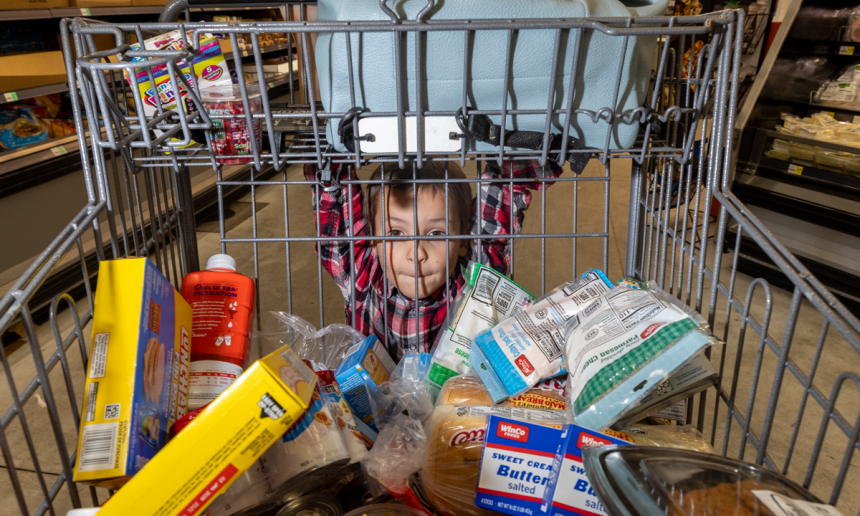After weeks of legal wrangling and piecemeal payouts, the federal food assistance program will be funded in full now that the nation’s record 43-day shutdown has ended.
The U.S. Department of Agriculture, which administers the Supplemental Nutrition Assistance Program, released guidance Thursday to states to proceed with full benefits for November and December.
Child and nutrition advocates are glad to see it resume, but have concerns about the multiple steps needed to relaunch SNAP — particularly around states’ ability to quickly arrange payments through third-party vendors.
Get stories like this delivered straight to your inbox. Sign up for The 74 Newsletter
Some 42 million Americans — including 16 million children, the elderly, veterans and those with disabilities — rely on SNAP for food.
“This is a unique situation,” said Claire Borzner, director for Share Our Strength and its No Kid Hungry campaign. “There has never before been a pause in SNAP payments or a recommendation for partial benefits.”
Borzner said states that issued incomplete payouts will need to ensure participants receive the remaining allotment.
The Trump administration first threatened to withhold SNAP benefits entirely for the month of November and then twice went to the U.S. Supreme Court in its legal quest to pay out only some benefits. It also moved to claw back money from states that went ahead and distributed 100% of benefits to their needy residents last week during a window of time when the USDA was authorizing it.
SNAP benefits have historically not been cut off during prior shutdowns and President Donald Trump faced criticism that he tried to leverage Americans’ hunger— 1 in 8 receive SNAP benefits — to break Democrats’ opposition to ending the shutdown.
Ongoing Legal Fight Leaves Millions of Americans in Limbo Over Food Assistance
Crystal FitzSimons, president at the Food Research & Action Center, said states are moving quickly to resume aid, though she understands some families might not feel relief until it arrives.
“It is very fluid and moving in real time,” she said, speaking of getting the program up and running again. “The delays have created so much stress for the people who really need food on the table. I totally understand why they would be worried, but the shutdown has ended and as soon as people see the money in their [Electronic Benefits Transfer] card, they should be able to take a deep breath and move forward.”
But Melissa Boteach, chief policy officer at ZERO TO THREE, an early childhood advocacy group, said “there has been a lot of undermining of the basic government infrastructure necessary” to get SNAP operational again.
Boteach noted families have been suffering needlessly since the start of the month, making tough choices about whether to eat or pay rent and utility bills.
“These are the conversations American families have been having around the kitchen table,” she said, calling SNAP a miracle and crediting it for preventing starvation-levels of hunger in this country since the 1970s.
Part of the confusion about when the aid might arrive centers around the uneven distribution of benefits. Stewart Fried, a principal attorney at OFW Law in Washington, D.C., and an expert on SNAP, said 19 states have already issued full November payments — the ones the administration told to “undo” those actions after the fact — while another 18 delivered partial allotments.
Fried, who has represented many SNAP-eligible retailers on a wide variety of issues before the USDA’s Food and Nutrition Service, Congress and in the federal courts, said states that issued partial payouts might need at least a week to disperse the remaining monies. The 13 states that sent out no money in November may face the easiest turnaround time.
“For states that have not issued any November benefits, that process should be quicker and benefits will hopefully be issued in the next few days,” he said.
Judges Rule Trump Can’t Completely Stop SNAP Aid
Meanwhile, low-income families have been flooding food pantries across the country all month while also relying on schools to help fill the nutrition gap for their kids, child advocates say.
Ian Coon, spokesman for the Alliance for Education, an independent, local education fund that supports Seattle Public Schools, said his group set aside $150,000 for grocery store gift cards in October. The school community raised an additional $70,000 in recent weeks to bridge any further gaps as kids head home for the holidays, some to empty cupboards.
The alliance has already distributed $154,000 in funding for kids and families in need.
“There have been increased donations to food pantries,” he said. “Nearly every local business has a food collection bin in the door and restaurants are still providing community meals or fundraising. This isn’t the time to standby. It’s the time to act and we’re so grateful to have the support of our community.”
Erika Roberson, senior policy associate at The Institute for College Access & Success, a research and advocacy group that addresses issues like food insecurity in secondary education, said she’s glad for the 1.1 million college undergraduates who rely on SNAP.
“When students receive their benefits, they will worry less about where their next meal will come from and will be able to focus on their studies,” she said, adding those who wrestle with food insecurity are more likely to struggle academically, taking on extra hours of work and leaving less time to attend class. “It’s a huge disadvantage.”
New Food Security Threats 5 Years After COVID-Era Effort to Feed All Kids
SNAP benefits have been ensured for a full year and therefore won’t be subject to disruption when the current continuing resolution to fund the government that was approved this week runs out in January. Recipients also still face the effects of the $186 billion eliminated from SNAP as part of the administration’s landmark One Big Beautiful Bill Act signed into law this summer.
Borzner called the most recent chaos around SNAP a manufactured crisis.
“Families should not have had to go through this pain,” she said, adding that the government had the resources to pay benefits in full. “This program could have continued to operate for November as it normally does. None of this needed to happen.”









